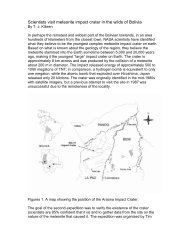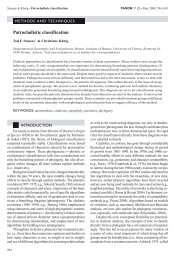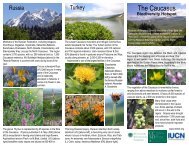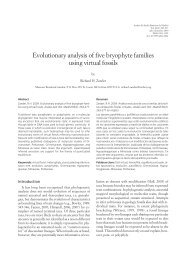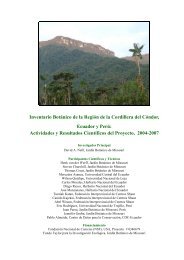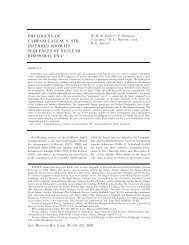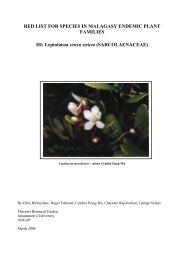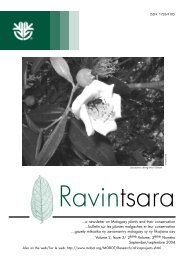...a newsletter on Malagasy plants and their conservation ...bulletin ...
...a newsletter on Malagasy plants and their conservation ...bulletin ...
...a newsletter on Malagasy plants and their conservation ...bulletin ...
Create successful ePaper yourself
Turn your PDF publications into a flip-book with our unique Google optimized e-Paper software.
METHODS FOR CONSERVATION/MÉTHODES POUR LA CONSERVATION<br />
ENVIRONMENTAL EDUCATION FOR CONSERVATION L’EDUCATION ENVIRONNEMENTALE POUR LA CONSERVATION<br />
Hans Raja<strong>on</strong>era<br />
Communicati<strong>on</strong>, MBG, Madagascar<br />
hans.raja<strong>on</strong>era@mobot-mg.org<br />
Successful c<strong>on</strong>servati<strong>on</strong><br />
must implicate the entire populati<strong>on</strong><br />
<strong>and</strong> therefore requires<br />
the participati<strong>on</strong> of all. However, in order for this participati<strong>on</strong><br />
to be effective the populati<strong>on</strong> must be educated so that<br />
they fully underst<strong>and</strong> the various envir<strong>on</strong>mental problems.<br />
The objective then of envir<strong>on</strong>mental educati<strong>on</strong> is the acquisiti<strong>on</strong><br />
of an ecological perspective by all including: the individual<br />
(from a young age), the family, the community, <strong>and</strong><br />
governmental <strong>and</strong> n<strong>on</strong>-governmental organizati<strong>on</strong>s.<br />
Envir<strong>on</strong>mental educati<strong>on</strong> is based <strong>on</strong> participative pedagogy,<br />
that is to say it must solicit the participati<strong>on</strong> from the<br />
target populati<strong>on</strong>. It is an active <strong>and</strong> interactive method.<br />
The process must therefore guide the individual towards an<br />
awareness of envir<strong>on</strong>mental problems – including an underst<strong>and</strong>ing<br />
of the<br />
causes <strong>and</strong> c<strong>on</strong>sequences<br />
of<br />
these problems;<br />
<strong>and</strong> promote a<br />
willingness to<br />
accept resp<strong>on</strong>sibility<br />
for the<br />
problems <strong>and</strong><br />
the search for<br />
soluti<strong>on</strong>s.<br />
Normally<br />
the educati<strong>on</strong>al<br />
process will<br />
include various<br />
types of activities<br />
including:<br />
- activities of<br />
observati<strong>on</strong> <strong>and</strong><br />
discovery (site<br />
visits are particularly<br />
useful as<br />
they avoid the need to use the imaginati<strong>on</strong> that can sometimes<br />
make underst<strong>and</strong>ing difficult)<br />
- academic activities (for example, the synthesis <strong>and</strong> interpretati<strong>on</strong><br />
of observati<strong>on</strong>s made during the site visit)<br />
- practical activities (to reinforce other educati<strong>on</strong>al activities<br />
<strong>and</strong> encourage a sense of involvement <strong>and</strong> pers<strong>on</strong>al investment<br />
in a c<strong>on</strong>servati<strong>on</strong> project: might include, for example,<br />
the c<strong>on</strong>structi<strong>on</strong> of fire breaks or tree planting)<br />
- promoti<strong>on</strong>al activities (in which the “student” is encouraged<br />
to share his new found underst<strong>and</strong>ing with others: the<br />
trainee becomes the trainer)<br />
Good envir<strong>on</strong>mental educati<strong>on</strong> emphasizes the interdependence<br />
between living things <strong>and</strong> n<strong>on</strong>-living things (the<br />
biotic <strong>and</strong> the abiotic). It will also emphasize the importance<br />
of <strong>plants</strong>: <strong>their</strong> role as the primary producers<br />
12 Ravintsara June/juin 2004<br />
Une c<strong>on</strong>servati<strong>on</strong> effective doit impliquer entièrement la<br />
populati<strong>on</strong> et par c<strong>on</strong>séquent requiert sa participati<strong>on</strong>. Pour<br />
que cette participati<strong>on</strong> soit efficace, la populati<strong>on</strong> doit être<br />
initiée, éduquée sur les différents problèmes envir<strong>on</strong>nementaux.<br />
La finalité de l'éducati<strong>on</strong> envir<strong>on</strong>nementale étant l’acquisiti<strong>on</strong><br />
par tous d’un réflexe écologique, elle doit c<strong>on</strong>cerner<br />
l’individu dès s<strong>on</strong> jeune âge. La famille, la communauté, les<br />
associati<strong>on</strong>s/organisati<strong>on</strong>s et les autorités (qui doivent prendre<br />
davantage compte de la dimensi<strong>on</strong> écologique du<br />
développement) s<strong>on</strong>t autant d’entités c<strong>on</strong>cernées. L’éducati<strong>on</strong><br />
envir<strong>on</strong>nementale est basée sur la pédagogie participative,<br />
c’est-à-dire qu’elle sollicite la participati<strong>on</strong> effective du publiccible.<br />
C’est la méthode active et interactive. Les processus de<br />
l’éducati<strong>on</strong> envir<strong>on</strong>nementale doivent d<strong>on</strong>c amener graduellement<br />
l’individu à prendre c<strong>on</strong>science des problèmes envir<strong>on</strong>nementaux,<br />
à comprendre<br />
et à<br />
acquérir des c<strong>on</strong>naissances<br />
sur les<br />
causes, les manifestati<strong>on</strong>s<br />
et les<br />
c<strong>on</strong>séquences de<br />
ces problèmes, à<br />
acquérir une compétence<br />
et un<br />
savoir-faire dans la<br />
recherche de soluti<strong>on</strong>s<br />
pour enfin<br />
aboutir au changement<br />
de comportement<br />
par la participati<strong>on</strong><br />
et la prise<br />
de resp<strong>on</strong>sabilité<br />
pour c<strong>on</strong>server la<br />
nature et protéger<br />
l’envir<strong>on</strong>nement<br />
par une gesti<strong>on</strong><br />
rati<strong>on</strong>nelle des ressources.<br />
Ainsi, à chaque étape corresp<strong>on</strong>dent des activités c<strong>on</strong>crètes<br />
qui réflètent cette éducati<strong>on</strong> :<br />
- les activités d’observati<strong>on</strong> et de découverte : la visite des<br />
lieux permet l’observati<strong>on</strong> ; elles aident l’imaginati<strong>on</strong> à se<br />
fixer sur les réalités et rendent aisée la comprehensi<strong>on</strong><br />
- les activités académiques : c’est la synthèse de ce que l’apprenant<br />
a observé durant sa sortie nature<br />
- les activités pratiques : c<strong>on</strong>crétiser l’éducati<strong>on</strong> envir<strong>on</strong>nementale<br />
par des activités telles que la c<strong>on</strong>fecti<strong>on</strong> de parefeux<br />
ou de pépinières ;<br />
- les activités promoti<strong>on</strong>nelles : l’apprenant maîtrise toutes les<br />
techniques qu’il a apprises et devient lui-même un éducateur.<br />
A working sessi<strong>on</strong> with the local people/Une séance de travail avec la populati<strong>on</strong> locale<br />
En fait, l’éducati<strong>on</strong> envir<strong>on</strong>nementale met en exergue les<br />
relati<strong>on</strong>s d’interdépendance entre les êtres vivants et les élé-<br />
F. Rakotoariv<strong>on</strong>y





